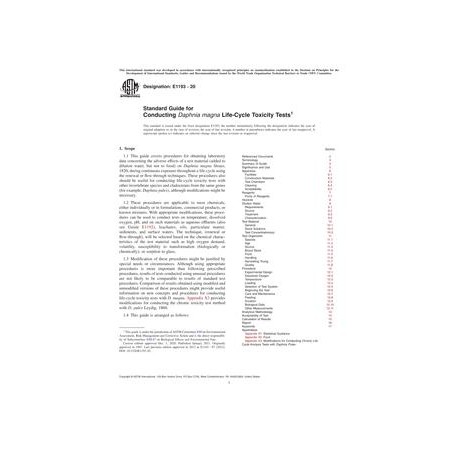No products
 View larger
View larger ASTM E1193-20
M00000574
New product
ASTM E1193-20 Standard Guide for Conducting Daphnia magna Life-Cycle Toxicity Tests
standard by ASTM International, 12/01/2020
In stock
More info
Full Description
1.1''This guide covers procedures for obtaining laboratory data concerning the adverse effects of a test material (added to dilution water, but not to food) on Daphnia magna Straus, 1820, during continuous exposure throughout a life-cycle using the renewal or flow-through techniques. These procedures also should be useful for conducting life-cycle toxicity tests with other invertebrate species and cladocerans from the same genus (for example, Daphnia pulex), although modifications might be necessary.
1.2''These procedures are applicable to most chemicals, either individually or in formulations, commercial products, or known mixtures. With appropriate modifications, these procedures can be used to conduct tests on temperature, dissolved oxygen, pH, and on such materials as aqueous effluents (also see Guide E1192), leachates, oils, particulate matter, sediments, and surface waters. The technique, (renewal or flow-through), will be selected based on the chemical characteristics of the test material such as high oxygen demand, volatility, susceptibility to transformation (biologically or chemically), or sorption to glass.
1.3''Modification of these procedures might be justified by special needs or circumstances. Although using appropriate procedures is more important than following prescribed procedures, results of tests conducted using unusual procedures are not likely to be comparable to results of standard test procedures. Comparison of results obtained using modified and unmodified versions of these procedures might provide useful information on new concepts and procedures for conducting life-cycle toxicity tests with D. magna. Appendix X3 provides modifications for conducting the chronic toxicity test method with D. pulex Leydig, 1860.
1.4''This guide is arranged as follows:
'' | '' | Section |
'' | '' | '' |
'' | Referenced Documents | 2 |
'' | Terminology | 3 |
'' | Summary of Guide | 4 |
'' | Significance and Use | 5 |
'' | Apparatus | 6 |
'' | '''Facilities | 6.1 |
'' | '''Construction Materials | 6.2 |
'' | '''Test Chambers | 6.3 |
'' | '''Cleaning | 6.4 |
'' | '''Acceptability | 6.5 |
'' | Reagents | 7 |
'' | '''Purity of Reagents | 7.1 |
'' | Hazards | 8 |
'' | Dilution Water | 9 |
'' | '''Requirements | 9.1 |
'' | '''Source | 9.2 |
'' | '''Treatment | 9.3 |
'' | '''Characterization | 9.4 |
'' | Test Material | 10 |
'' | '''General | 10.1 |
'' | '''Stock Solutions | 10.2 |
'' | '''Test Concentrations(s) | 10.3 |
'' | Test Organisms | 11 |
'' | '''Species | 11.1 |
'' | '''Age | 11.2 |
'' | '''Source | 11.3 |
'' | '''Brood Stock | 11.4 |
'' | '''Food | 11.5 |
'' | '''Handling | 11.6 |
'' | '''Harvesting Young | 11.7 |
'' | '''Quality | 11.8 |
'' | Procedure | 12 |
'' | '''Experimental Design | 12.1 |
'' | '''Dissolved Oxygen | 12.2 |
'' | '''Temperature | 12.3 |
'' | '''Loading | 12.4 |
'' | '''Selection of Test System | 12.5 |
'' | '''Beginning the Test | 12.6 |
'' | '''Care and Maintenance | 12.7 |
'' | '''Feeding | 12.8 |
'' | '''Duration | 12.9 |
'' | '''Biological Data | 12.10 |
'' | '''Other Measurements | 12.11 |
'' | Analytical Methodology | 13 |
'' | Acceptability of Test | 14 |
'' | Calculation of Results | 15 |
'' | Report | 16 |
'' | Keywords | 17 |
'' | Appendixes | '' |
'' | '''Appendix X1'''Statistical Guidance | '' |
'' | '''Appendix X2'''Food | '' |
'' | '''Appendix X3'''Modifications for Conducting Chronic Life Cycle Analysis Tests with Daphnia Pulex | '' |
1.5''The values stated in SI units are to be regarded as standard. No other units of measurement are included in this standard.
1.6''This standard does not purport to address all of the safety concerns, if any, associated with its use. It is the responsibility of the user of this standard to establish appropriate safety, health, and environmental practices and determine the applicability of regulatory limitations prior to use. Specific hazard statements are given in Section 8.
1.7''This international standard was developed in accordance with internationally recognized principles on standardization established in the Decision on Principles for the Development of International Standards, Guides and Recommendations issued by the World Trade Organization Technical Barriers to Trade (TBT) Committee.

